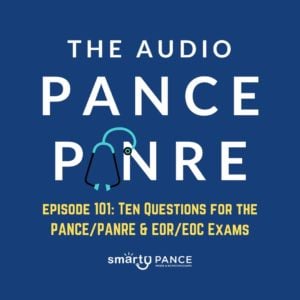Podcast Episode 101: Ten PANCE, PANRE, and Rotation Review Questions
Description
 Welcome to episode 101 of the Audio PANCE and PANRE Physician Assistant/Associate Board Review Podcast.
Welcome to episode 101 of the Audio PANCE and PANRE Physician Assistant/Associate Board Review Podcast.
Join me today as we cover ten board review questions for your PANCE, PANRE, and rotation exams.
Special from today’s episode:
- Join the Smarty PANCE Member’s Community then sign up for a study group to get updates about upcoming webinars.
- Check out our updated End of Curriculum™ (EOC) Exam Course
- Sign up for the Entire Blueprint Email Series
- Follow Smarty PANCE and The Daily PANCE Blueprint on Instagram
- Follow Smarty PANCE and The Daily PANCE Blueprint on Facebook
I hope you enjoy this free audio component of the examination portion of the Smarty PANCE website. The full board review website includes over 2,000 interactive board review questions, flashcards, and blueprint lessons available to all members of Smarty PANCE.
- You can download and listen to past FREE episodes here, on iTunes, Spotify, Google Podcasts, Stitcher, and most podcasting apps.
- You can listen to all the latest episodes, take interactive quizzes, and download more resources on each episode page.
Listen to Podcast Episode 101: Ten PANCE, PANRE, and Rotation Review Questions
If you can’t see the audio player, click here to listen to the full episode.
Interactive exam to complement today’s podcast
1. A 75-year-female smoker with a history of atrial fibrillation and hypertension presents to the ER complaining of a 2-hour history of right-sided weakness and aphasia that has now resolved. Her physical exam and vital signs are completely unremarkable. CT head is unremarkable. Which of the following is the most likely diagnosis?
A. Subarachnoid hemorrhage
B. Transient ischemic attack
C. Cerebral venous sinus thrombosis
D. Multiple sclerosis
E. Complicated migraine
The answer is B. Transient ischemic attack
The patient had a transient ischemic attack (TIA), which is characterized by transient neurological symptoms without objective evidence of acute infarction. Symptoms vary, but patients may have hemiparesis, hemiplegia, aphasia, or vision loss. Risk factors include alcohol, hypertension, smoking, diabetes, illicit drug use, and atrial fibrillation.
Urgent evaluation is needed in patients with symptoms of TIA (e.g., coagulation studies, TTE, EKG, CT or MRI head, imaging of the cervicocephalic vasculature via carotid US, CTA, or MRA). Treatment for high-risk patients includes dual antiplatelet therapy (ASA + clopidogrel) for 21 days and risk factor management (statin, exercise, etc). Remember the risk of an actual stroke is high after a TIA.
Smarty PANCE Content Blueprint Review:
Covered under ⇒ PANCE Blueprint Neurology ⇒ Vascular Disorder ⇒ Transient ischemic attack
Also covered as part of the Internal Medicine EOR, Family Medicine EOR, and Emergency Medicine EOR topic list
2. A 26-year-old female presents with a history of miscarriages and recurrent pulmonary embolism. She is diagnosed with antiphospholipid syndrome. Which of the following is the mainstay of treatment for this condition?
A. Dual antiplatelet therapy (DAPT)
B. Aspirin and heparin
C. Dabigatran
D. Warfarin
E. Heparin
The answer is D. Warfarin
Antiphospholipid syndrome (APS) is an autoimmune disease defined by venous thromboembolism, arterial thrombosis, and obstetric morbidity in the presence of circulating antiphospholipid antibodies (aPLs). It is the most common form of acquired thrombophilia.
aPLs include lupus anticoagulant, anticardiolipin, anti-b2-glycoprotein I antibodies. Clinical features include DVTs (32%), thrombocytopenia (22%), livedo reticularis (20%), stroke (13%), PEs (9%), and fetal loss (8%). The mainstay of treatment is warfarin. Other anticoagulants have been found to be less effective than warfarin so far.
Smarty PANCE Content Blueprint Review:
Covered under ⇒ PANCE Blueprint Hematology ⇒ Coagulation Disorders ⇒ Hypercoagulable states
Also covered as part of the Internal Medicine EOR and Emergency Medicine EOR topic list
3. Which of the following is the most common cause of acute bronchitis in the United States?
A. Virus
B. Bacteria
C. Fungus
D. Allergies
E. Tuberculosis
The answer is A. Virus
Acute bronchitis is characterized by a cough due to inflammation of the large airways and trachea with no evidence of pneumonia. Acute bronchitis often follows an upper respiratory infection. The most common cause of acute bronchitis is viral. Symptoms include cough (10-20 days), headache, shortness of breath, and wheezing. The presence of fever should make you consider pneumonia or influenza.
Diagnosis is clinical. A chest radiograph should be given if it is hard to clinically distinguish between pneumonia and bronchitis. Treatment is mainly supportive care (rest, hydration) and symptomatic management (antitussives for cough, bronchodilators for wheezing, etc). Antibiotics should NOT be given for acute bronchitis.
Smarty PANCE Content Blueprint Review:
Covered under ⇒ PANCE Blueprint Pulmonary ⇒ Infectious Pulmonary Disorders ⇒ <a class="dt-sc-lesson-menu-name dt-sc-tooltip-right" href="https://smartypance.com/lessons/infectious-disorders/acut







